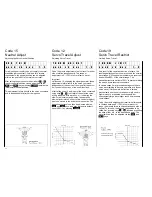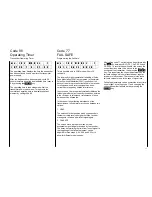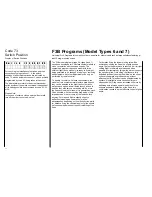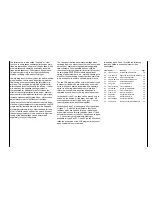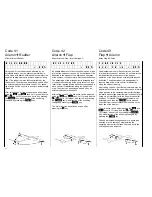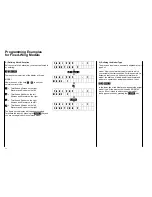
31
1. Channel Allocation (Code 51)
To program a mixer first call code 51, via which the
channels to be linked are determined.
On the display then appears “MIX ?”, asking the
operator to input the number of the mixer to be used.
After the number has been input, the display changes
to:
M I X 1
I N H
With INH meaning Inhibited.
This indicates that the mixer is not yet active,
otherwise the numbers of the already allocated
control channels will be displayed instead of INH.
Start by entering the control functions by keys
1
…
9
,
which are to act is input signal of the mixer. If the
dummy mixer indicated by “0” is to be used press
INC
, or if the preceding mixer is to be used as the
input press the
DEC
key before the input function
number, which will be indicated by an arrow in front of
the input channel. Then input the control channel
(=servo output) into which the signal will be mixed.
M I X 1
4 8 T R I M O F F
If, as in the example above, the input is one of the
control functions 1 – 4, it can be decided whether trim
is also to affect the mixer input or not. Pressing the
INC
or
DEC
key will enable the trim, whilst pressing
the
CLEAR
key will disable it.
M I X 1
4 8 T R I M O N
Channel allocation of the mixers is confirmed by the
ENTER
key. Programming can be continued by
entering the next mixer number, or terminated by
pressing the
ENTER
key again.
2. Allocation and Polarity Reversal of External
Switches (Code 33)
A switch which allows the mixer to be turned on and
off is allocated to the mixer by code 33.
M I X E R 1 2 3 4 5 6 7 8 9
S W I T C H 9 9 9 9 9 9 9 9 9
The upper line indicates the mixer numbers, with the
allocated switches shown on the bottom line.
Switches are allocated by entering the number of the
mixer, whereupon a “?” appears in the lower line, and
then entering the desired switch number, the polarity
of which can be reversed by pressing the
DEC
key
first. The phantom switch “9” can be used, in which
case the mixer remains permanently on (basic setting
of all mixers). When in doubt, switch number and
switch position can be established quickly and reliably
using code 73.
3. Adjusting the Symmetrical Mix Quota
(Code 61)
If a symmetrical (common) mixer (in relation to the
neutral point) is required, the mix quota and direction
is set using code 61.
M I X 1 C O M 4 8 w /
o f s 0 - S + 5 0 %
Mix quota is adjusted using the
INC
and
DEC
keys,
the process can be speeded up by pressing the
6
or
8
key, which increases or decreases the value in
steps of 10 respectively. The direction of mixing is
determined by the + or – prefix to the mix quota, and
can be changed by pressing the
TURN
key.
To alter the neutral point of the mixer, shift the
corresponding operating element (stick, etc.) into the
required position and press the
STORE
key. The
offset from the normal neutral point captured in this
way is transferred to the display.
Adjustment is confirmed by pressing the
ENTER
key. Afterwards, further mixes can be adjusted by
entering their number, or the adjustment process
terminated by pressing the
ENTER
key again.
4. Adjusting the Symmetrical Mix Quota
(Code 71)
Code 71 permits adjusting separate mix quota and
mix directions for the two sides of the control function
at the mixer inlet.
M I X 1 S E P 4 8 w /
o f s 0 - S + 2 8 %
The setting of the mix quota is performed in the same
way as for code 61 using the
6
,
8
,
INC
and
DEC
keys. In this case the operating element has to be set
to the side requiring adjustment (displayed with the
or – ahead of “s”). The direction of mixing can
be adjusted separately for either side using the
TURN
key. Neutral point offset is achieved by
moving the operating element of the control function
to the required position and capturing the value using
the
STORE
key.
Summary of Contents for mc-18
Page 1: ...1...
Page 10: ...Block Diagram NORMAL 10...
Page 11: ...Block Diagram NORMAL DIFF 11...
Page 12: ...Block Diagram DELTA DIFF 12...
Page 13: ...Block Diagram UNIFLY DIFF 13...
Page 14: ...Block Diagram Quadro Flap 14...
Page 15: ...Block Diagram F3B 3 wing servos 15...






